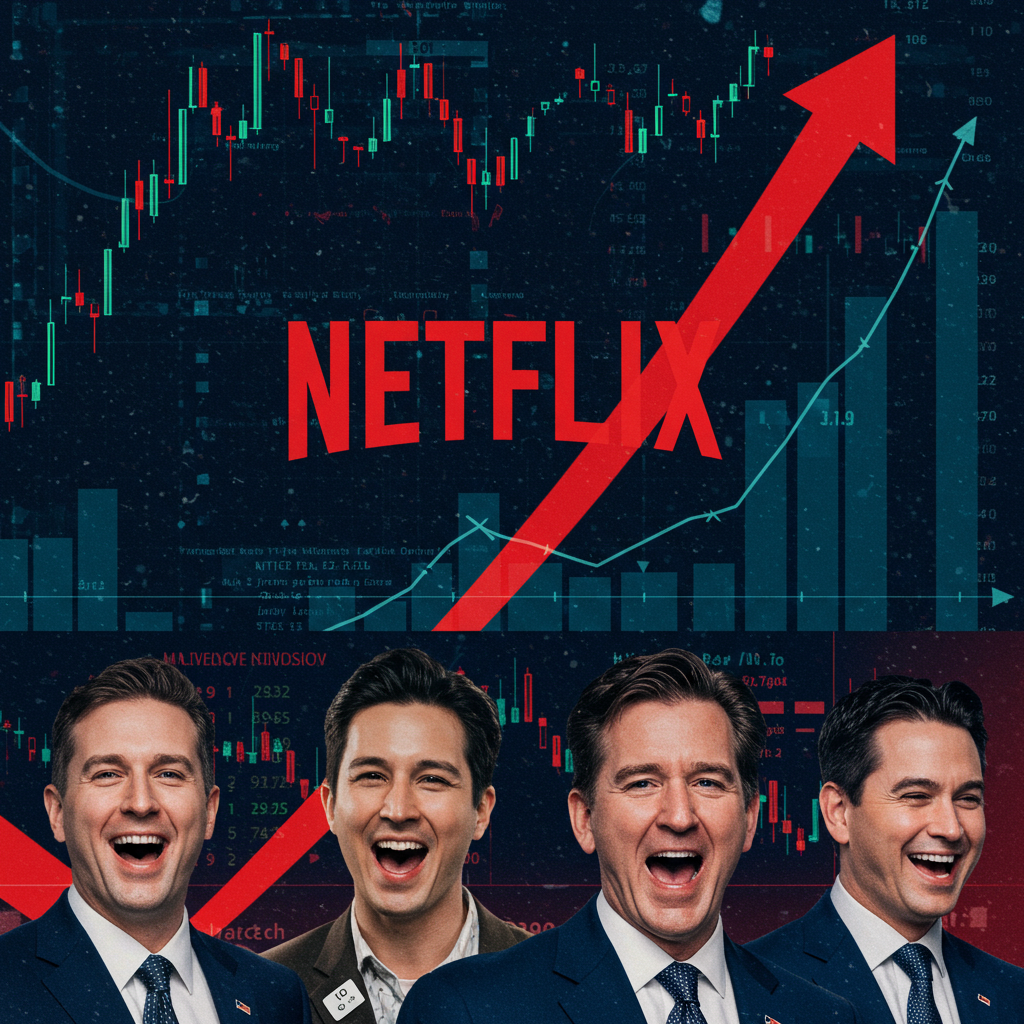Wall Street eagerly awaits Netflix’s third-quarter 2025 earnings report, anticipating robust performance. Despite lingering concerns about AI’s potential impact on the streaming landscape, analysts remain largely bullish. A breakout animated film, a strong content pipeline, and strategic monetization efforts like the ad-supported tier are driving this optimism. Investors are keenly focused on how these factors will shape Netflix’s Q3 performance and future growth trajectories.
KPop’s Unexpected Dominance: A Q3 Game Changer
The standout success of the Sony animated film, “KPop Demon Hunters,” is poised to be a central talking point for Netflix’s Q3 earnings. This movie has become the service’s most successful ever. Wall Street analysts credit this hit with significantly boosting user engagement and likely increasing subscriber numbers during the recently concluded third quarter.
Bernstein analyst Laurent Yoon highlighted the film’s substantial contribution. He noted that “KPop Demon Hunters” spearheaded a global engagement rebound for Netflix in Q3. This reversed a dip experienced in the previous quarter. Yoon estimated the film added approximately 500 million viewing hours in Q3 alone. Another 400 million are expected in the fourth quarter. He called this magnitude of success “atypical for Netflix, or any player.” Bank of America analyst Jessica Reif Ehrlich also pointed to the film’s impact. She noted it became the “most watched Netflix film of all time” by August. This demonstrated Netflix’s remarkable ability to scale massive hits from relatively unknown intellectual property.
Subscriber Growth Powered by Global Appeal
The animated phenomenon is also expected to translate into significant subscriber gains. Laurent Yoon projects around 7 million net subscriber additions for Netflix in the third quarter. He observed strong growth in international regions, particularly Latin America. Non-English content remains a powerful engine for this expansion. It particularly appeals to younger audience segments.
Benchmark analyst Daniel Kurnos offered a slightly more conservative forecast. He predicted a gain of 5.8 million subscribers. This would comfortably push Netflix beyond 320 million global paying subscribers. These figures underscore the platform’s continued global reach and its success in tapping diverse markets.
Navigating the AI Frontier: Threat or Opportunity?
Despite the positive content and subscriber outlook, Netflix stock has seen some underperformance. Shares lagged the Nasdaq since June. This largely stems from investor anxiety surrounding the AI threat. Specifically, concerns center on how AI-generated content might impact streaming economics and future engagement.
Wolfe Research analyst Peter Supino pointed to the rapid rise of AI video generators. These include Google’s Veo 3, Meta’s Vibes, Midjourney’s AI video generator, and OpenAI’s Sora 2. While currently limited to short-form video, these advancements fuel worries. They suggest AI video creation could degrade the perceived value of streaming leadership.
However, many analysts offer a counter-narrative. They argue that Netflix’s vast scale, rich cash flow, and expanding growth strategies position it uniquely. This allows it to extend its lead in long-form video streaming. It continues to capture wallet share from traditional pay-TV. BMO Capital Markets analyst Brian Pitz even views Netflix as a significant “AI beneficiary.” He believes AI can enhance content creation workflows. It can expand creator capabilities and drive user engagement. Pitz forecasts a “multi-year operating income unlock opportunity” for the company.
Monetization Levers: Ads, Price Hikes, and New Ventures
Beyond content, Netflix’s Q3 earnings report will also shine a light on its evolving monetization strategies. The ad-supported tier is a key focus. Analysts expect significant progress here. Daniel Kurnos forecasts that the AVOD tier could represent an estimated one-third of all global paid users in Q3. This would be an intriguing milestone, signaling rapid adoption.
Netflix has also implemented strategic price increases. These include raising the U.S. ad-supported tier and premium tiers. Similar adjustments occurred in Canada, Portugal, and Argentina. Analysts expect these price hikes to boost average revenue per member (ARPM). They should drive substantial revenue growth in both 2025 and 2026.
New initiatives are also on the horizon. The upcoming integration of Spotify video podcasts is a notable development. These will arrive on Netflix in the U.S. in early 2026, with other markets to follow. Initial titles include “The Bill Simmons Podcast” and “The Rewatchables.” Brian Pitz views this deal, alongside a continued push into gaming and the AVOD ramp-up, as key drivers for incremental growth in 2026.
A Powerhouse Content Slate Driving Engagement
While “KPop Demon Hunters” took center stage in Q3, Netflix’s broader content strategy continues to impress. The company has successfully executed its high-profile live event strategy. The “Canelo-Crawford” boxing match brought in an estimated 41.4 million viewers. This made it the most-viewed men’s championship boxing match of the century. Other successful Q3 releases like the return of “Squid Game” and “Wednesday,” and new hit “Untamed,” also provided a tailwind for engagement.
Looking ahead, the Q4 2025 content slate promises further acceleration. It features highly anticipated titles. These include the final season of “Stranger Things,” the “Jake Paul vs. Tank Davis” event, and NFL content on Christmas Day. “Monster” and “The Witcher” are also on the schedule. This robust pipeline is expected to drive accelerated member engagement into year-end and sustain growth into 2026.
Wall Street’s Overwhelmingly Bullish Outlook
Despite the shadow of AI, Wall Street analysts maintain a strong bullish stance on NFLX stock. Ratings range from “buy” to “outperform,” with ambitious price targets between $1,390 and $1,500.
Morgan Stanley’s Benjamin Swinburne remains bullish. He expects strong second-half 2025 financial results. He projects potential advertising upside and engagement growth. He maintains an “overweight” rating with a $1,500 stock price target.
Wolfe Research’s Peter Supino similarly advises buying Netflix shares. He acknowledges sharp third-quarter stock underperformance, but sticks to an “outperform” rating and $1,390 target.
Bank of America’s Jessica Reif Ehrlich anticipates Q3 results to be at least in line with guidance. She has a “buy” rating and a $1,490 price objective.
UBS analyst John Hodulik and Guggenheim’s Michael Morris also hold “buy” ratings. They have price targets of $1,495 and $1,450 respectively, citing the strong content slate.
While most are optimistic, Benchmark analyst Daniel Kurnos maintains a “hold” rating. He remains cautious due to the stock’s high valuation. He also points to the “lurking specter” of Netflix pursuing a major M&A deal like Warner Bros. Discovery. However, Netflix co-CEO Greg Peters has expressed skepticism about such large media deals. Analyst Laurent Yoon concurs, deeming it an unlikely outcome with unclear strategic value.
Financial Projections and The Road Ahead
Analysts predict strong financial results for Netflix in Q3. Bank of America expects the company to meet or exceed guidance on key metrics. These include revenue, operating income, and earnings per share. UBS anticipates 17% revenue growth and 25% operating income growth in the third quarter. This aligns with management guidance. It is fueled by member growth, higher pricing, and increased ad revenues.
The long-term outlook remains positive. Analysts commend Netflix for stable content spending, typically around $17 billion to $18 billion annually. This contributes to predictable free cash flow. This cash flow can be leveraged for strategic investments or share repurchases. Netflix is seen as a leader in the global streaming race. Its compelling price-to-entertainment value and expanding ad-supported offering are expected to drive both solid subscriber and average revenue per user (ARPU) growth. This combination should expand Netflix’s competitive moat, ensuring sustained leadership.
Frequently Asked Questions
What was the main content driver for Netflix’s engagement in Q3 2025?
The Sony animated film “KPop Demon Hunters” was the primary content driver for Netflix’s engagement in the third quarter of 2025. Analysts noted it became the service’s most successful movie ever. It contributed an estimated 500 million viewing hours in Q3. This success significantly boosted global engagement and is expected to drive subscriber additions. Its magnitude was considered “atypical” for the platform.
How are analysts addressing the potential threat of AI-generated content to Netflix?
Analysts acknowledge the emergence of advanced AI video generators, like OpenAI’s Sora 2. These tools raise concerns that AI could degrade streaming value, particularly for short-form video. However, many remain bullish on Netflix. They argue that Netflix’s superior scale, widening growth strategies, and strong cash flow position it to extend its lead in long-form video. Some even see AI as an opportunity, enhancing content creation and driving user engagement, rather than solely a threat.
What key strategic initiatives will drive Netflix’s growth beyond Q3 2025?
Beyond Q3, Netflix is leveraging several strategic initiatives for future growth. The expansion of its ad-supported tier is expected to become a major revenue driver, potentially comprising one-third of global paid users. Price increases across various tiers will also boost ARPM. Furthermore, new content, including a robust Q4 2025 slate and a strong 2026 lineup, will maintain engagement. The integration of Spotify video podcasts and continued ventures into gaming are also anticipated to fuel incremental growth.
Conclusion
Netflix approaches its third-quarter 2025 earnings with a powerful story of content-driven success, led by “KPop Demon Hunters.” While the specter of AI-generated content looms, Wall Street analysts largely maintain a bullish stance. They see Netflix’s strategic positioning, robust content pipeline, growing ad-supported tier, and global scale as formidable advantages. These factors are expected to drive continued subscriber growth and financial performance. As the streaming giant navigates an evolving media landscape, its ability to innovate and deliver compelling value will be key to solidifying its long-term leadership.


